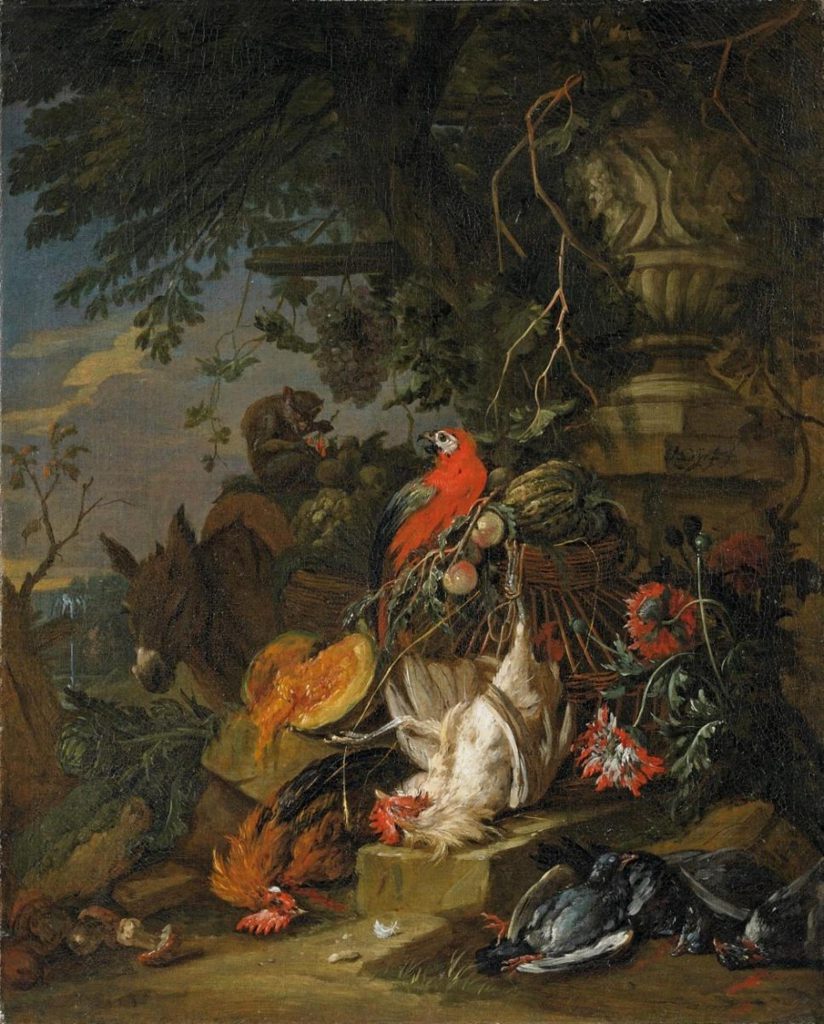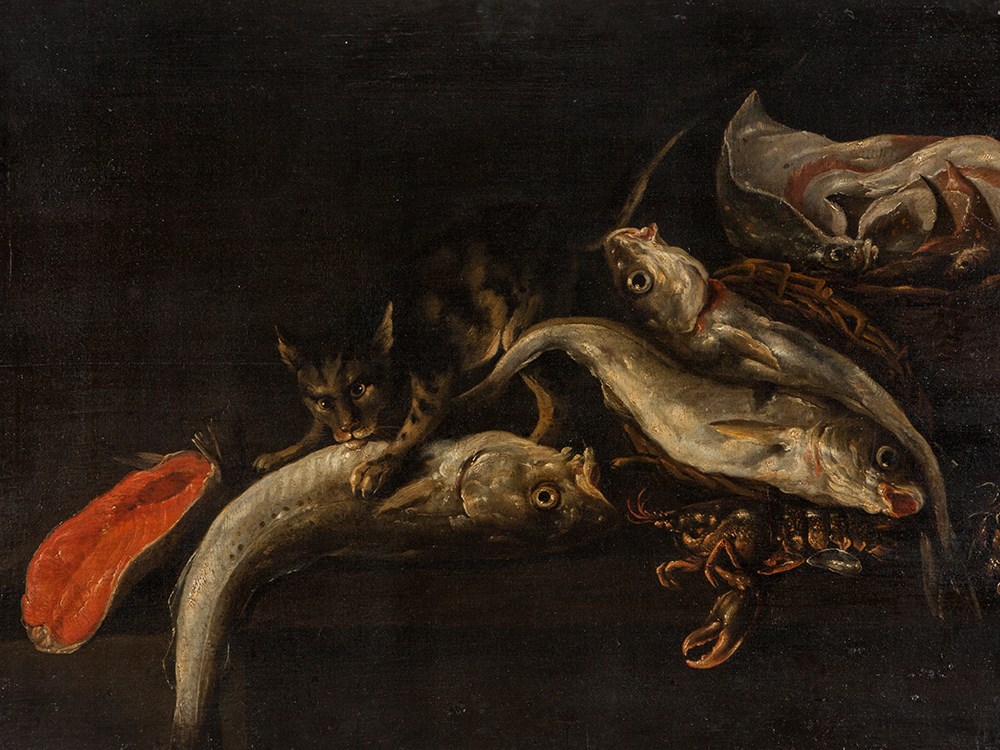Painting Is a Work of Art Which Uses a Still Life as a Metaphor for the Inevitability of Death
Have you lot ever wondered what meanings are hidden behind 17th-century still-life paintings?
When these artworks were painted, their audience could understand what messages were conveyed at the get-go glance. However, for a modern audience, these still-life scenes can look like just random supermarket objects. At the Mearto Magazine, we have decoded the symbols of this timeless style of art for you.

A Still Life (Stillleben, Stillleven or Nature Morte) is a work of art depicting mostly inanimate bailiwick matter –flowers, food, expressionless animals, shells or man-made objects such as drinking glasses, books, vases, jewelry, musical instruments and so on-, gathered on a table or in a niche, sometimes with "Vanitas" elements that reminded the emptiness of cloth pursuits and futility of earthly ambitions. Classic All the same Life Painting: A Gimmicky Master Shows How to Reach Old Chief Effects Using Today's Fine art Materials
The rich centre class had disposable income and collecting paintings –especially yet life- was a practiced way to plant a high position in society equally a connoisseur, showcasing their practiced gustatory modality and wealth.
Equally a field of study thing, notwithstanding-life painting is popular since antiquity. Ancient Greeks and Romans oft decorated their homes with depictions of fruit baskets, game or other still-life scenes. Subsequently in the grade of art history, still-life painting emerged more than or less simultaneously in Italy, northern Europe, and Kingdom of spain in the sixteenth century, while the Dutch still life painting became the nigh lavish, near sought-afterwards type.
These simple paintings of flowers, food and such gathered together had complex meanings and various messages for the viewers and sometimes it could be the sole reason why a sure person bought a sure painting. The Suburbia's involvement in buying art opened up a new market place for art, which was the beginning of the starting time art economic system in the modern sense. The rich centre class had disposable income and collecting paintings –specially still life- was a good manner to establish a high position in society as a connoisseur, showcasing their good taste and showing off their wealth. This is the exact reason that all the same life paintings often feature objects of trade, probably because it convinced a merchant to buy a significant painting with objects of his trade: for example, a grape merchant who imports grapes from Spain would be delighted to buy a yet life with grapes.
The conservative values of the era afflicted the letters conveyed by the still life paintings heavily. The primal "memento mori" theme (literally "remember that yous take to die") in Vanitas Withal Life reminded the viewer non to go too lost in enjoying oneself with wealth, gluttony and music only rather to focus more on the spiritual aspects of life. Then one could be convinced into morality while also enjoying an flavory, abundant feast scene with exotic fruit, lobster, and wine. Let's take a look at the meanings hidden in these unproblematic objects.

Oyster:
Often symbols of erotic intent, oysters take been a sort of gourmet food since antiquity. Ancient Greeks and Romans saw oyster as a effeminateness, aphrodisiac and a medical remedy. Aphrodite -or Venus-, the Goddess of Dear, was conceived in an oyster and sailed to the island of Republic of cyprus, where she was born from the oyster shell. Thus, it is no surprise that oyster is considered an aphrodisiac, a discussion derived from Aphrodite.
Bread:
Everyday life, humility, Catholic host (the trunk of Christ)
In this painting the empty oyster shells are on the table with ii uneaten oysters invitingly open up to the viewer'southward gaze, while the elementary bread roll remains on the lower right side of the painting, which suggests these banqueters enjoyed the pleasures of the flesh, hence ignored their conservancy, leaving the bread of life, or the sacred flesh of Jesus Christ on the side.
The items that indicate trade are wine and the pepper or table salt sprinkler in the background. The shrimps like all shellfish are symbols of wealth and also gluttony, while peeled lemon, as an expensive fruit for that fourth dimension, as well stands for wealth. Expensive delicacies such equally shellfish and lemons were associated with a privileged and gentle lifestyle, which the owner already enjoyed or wanted to exist identified with. It is possible they don't carry a significant allegorical purpose but just stand as general reminders of the transient nature of luxury, the virtue of temperance, or warn against the perils of gluttony.

This classical fruit still life of pure elegance, executed during the late creative period of the artist, Jacob Marrel is going nether the hammer on Fri, Aug 26, 2016, iii pm CET at Auctionata. Jacob Marrelwas a well-known follower of the Dutch School of the 17th century, whose works occasionally fetch upward to six-figure hammer prices at international auctions. Let's have a wait at the symbolism in the painting:
Snail:
From Matisse to the Quondam Masters, snails are commonly depicted in art and carry rich symbolism. Since early on Renaissance, snails were considered an image of the Virgin Nascence and the dogma of the Immaculate Conception of Mary, maybe because people could not imagine how snails would reproduce. Some resources site snails also as symbols for humility and everyday life.
Medlar:
Seen on the lower right of the painting, medlar is seen as a fruit, which is rotten before it is ripe, and used every bit a symbol of prostitution, decaying morals or premature destitution. It is possible that the artist is contrasting them confronting the grapes, signifying Christian devotion, which the snail in the middle is going towards, the rather than the medlars, signifying rotten morals.
Bee:
A bee in a withal life painting signifies the brittleness of life and how helpless we are against the class of destiny, besides encourages industriousness. This is unlike than other insects depicted in nonetheless life painting, devouring the fruit or dead animals, which signifies death and "memento mori".

This oil on canvas piece of work from the 17th century the netherlands is a part of the Archetype Works of Art – Paintings of the 16th – 20th Century on Auctionata. The Dutch still life painter Isaac van Duynen(1628 – ca 1680) was agile in the Golden Historic period and is mostly renowned for his outstanding fish yet lifes.
The fish are painted in bright colors and clearly stand out from the dark. Amongst them, i tin can recognize the shining shell of a lobster. In the center of the painting appears a true cat, sinking its teeth into a fish.
Fish and true cat:
Expiry as a general theme appears in this painting with the dead fish beingness eaten past a cat. Fish was a symbol for Christ and cats were considered images of indiscretion or unteachable beings that aid evil. And then perchance the creative person is trying to warn against a danger to faith, maybe by gluttony hidden in the shining beat out of the lobster below the fish.

Another highlight from the Archetype Works of Art – Paintings of the 16th – 20th Century at Auctionata is this Still Life by a follower of the French painter Jean-B. Monnoyer, famous for his notwithstanding life paintings. This piece is as well total of hidden vanitas messages. Vanitas is a category of symbolic works of art, peculiarly associated with 16th and 17th century still life. The Latin nounvānĭtasliterally ways "emptiness" and the fundamental theme in these paintings is the Christian view of earthly life and the worthlessness of all wealth and ambitions. This painting is full of those messages.
Rose:
Roses with thorns symbolize Virgin Mary's suffering.
Violin:
The violin, with its easily snapped strings, symbolizes the cleaved threads of time and indicates the futility of earthly existence.
Flute:
Since aboriginal times, air current instruments are identified every bit phallic objects, associated with sexual subcontext. In the Aboriginal Greek legend of the musical contest between Apollo and Marsyas, Apollo's lyre stood for harmony and clarity while the Marsyas' double flute was the Bacchic musical instrument that aroused passion. Overall, music, frequently associated with lust and ephemerality of life, was depicted especially as a warning confronting a lazy and sinful life.
Glass:
The almost empty glass signifies brittleness of life only besides since glass was an expensive object, information technology stood for a life of luxury.
Gold or argent objects:
Expensive luxury items depicted wealth and power in still life paintings, however, when they are tipped over, as in this painting, the bulletin encourages moderation and reminds the transience of earthly riches.

Another example of vanitas nevertheless-life painting is this work by Ottmar Elliger the Elderberry. Ellinger'due south ability to provide highly detailed optical effects stands out beautifully in this extremely well-preserved panel. Here, for example, the Ruddy Admiral butterfly floats beside the breezy still-life arrangement, thus expanding the picture airplane and emphasizing the seeming randomness and spontaneity of an arranged scene, as if these objects came together on their own.
Nautilus Shell:
The nautilus shell serves as a replacement to the more omnipresent depiction of the human skull, acting as a reminder of the inevitability of death, or memento mori while keeping the grim epitome of a skull out of the motion-picture show.
Butterfly:
The butterfly represents the soul, transformation and resurrection, and the hope of the caterpillar to emerge out of a cocoon as a beautiful butterfly.
Pomegranate:
Fertility, want, abundance, simply likewise resurrection and immortality, inspired by the mythological story of Persephone and Hades.
Peaches:
Peaches stand as an epitome of the trade from warmer countries but likewise, the artists of Renaissance symbolically used peach to correspond the heart, while a ripe peach was also a symbol to imply a ripe land of good health.
Vine Leaves and grapes:
The vine leaves enclosing the food could be representing Christian values and Jesus, as a reminder of the wine Jesus offered to his apostles at the Last Supper. They could also be symbolizing earthly pleasures, through the God of Wine, Bacchus.
Lobster:
All pieces of meat, ham, game, and shellfish symbolize wealth, gluttony and temptation while drawing attention yet over again to the transience of wealth.
Want to acquire more well-nigh this topic?
Here are a few books that volition take you deeper into the world of Still life paintings.
href="https://www.amazon.com/gp/product/0300225911/ref=as_li_tl?ie=UTF8&camp=1789&creative=9325&creativeASIN=0300225911&linkCode=as2&tag=mearto-20&linkId=4093a4eb439bd038ab0941bfc06150d3″ target="_blank" rel="noopener">





Source: https://blog.mearto.com/2016/08/11/decoding-the-hidden-meanings-in-still-life-painting/
Post a Comment for "Painting Is a Work of Art Which Uses a Still Life as a Metaphor for the Inevitability of Death"